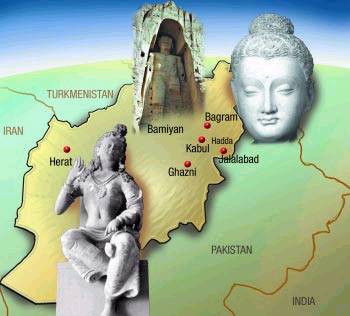SITES UNDER SIEGE

BAMIYAN: A convenient halt for trading caravans on the ancient
Silk Route. Attained global fame for the world's two tallest standing Buddhas, measuring
55 and 38 m, hewn out of a rock. Largest number of Buddhist caves (around 20,000) have
been dug there. The two Buddhas had faced Changez Khan's massacres and Mughal emperor
Aurangzeb's cannon shots before facing Taliban tanks on Friday.
JALALABAD: Once the most sacred centre of Buddhism in Afghanistan.
Known for Buddhist monuments, monastic establishments (44 stupas, temples, shrines and
caves) and antiquities, particularly art objects having the Greco-Roman touch for which
Hadda was archaeologists' favourite. Among sculptures and other antiquities, most notable
was skull bone of Buddha, his robe and lathi (stick).
GHAZNI: Falling on the second route connecting the sub-continent
with Khorasan, Persia and Asia Minor, via Kandahar, Ghazni was probably a part of Mauryan
empire. Ashoka built ten stupas and `Deva' temples. Attained prominence during the rule of
Kushanas and assumed significance as a centre of later Buddhism. It has a Buddhist complex
at Humau Qala, decorated vihars; traits of Hinduism evident with the presence of cult of
Durga (an image Mahisamardini, Goddess Durga slaying demon Buffalo found).
KAPISA (Now BAGRAM): Known to be one of the oldest towns of
Afghanistan, Panini refers it as famous for wine. But it was known primarily as the summer
capital of the Kushanas. Was the place for one of the Buddhist Councils and has the ruins
of the palace of great Kanishka. Yielded dozens of stupas; images of Buddha, panels of
life scenes of `The Great Teacher', and reliefs depicting Jataka scenes.
HERAT: Basically an Islamic site. ASI restored two Islamic
monuments among which one was a Timurid tomb. It has yielded priceless Hindu statues and
images. Marble images of Surya(Sun God) and Shiv Parvati were most famous.
KABUL MUSEUM: Modern Kabul was virtually a depository of priceless
antiquities and rare heritage objects. It was looted often and faced acts of vandalism,
particularly after the Soviet Union withdrew its forces. Among the valuable pieces, the
most famous were: A Sun God image in marble, a Bodhisattva (clay) in meditation posture;
home to the artefacts belonging to the Kushana period of which headless Kanishka in salwar
kameez was rare.
- Photo Gallery
- Taliban Destroy Bamiyan
Buddhas in Afghanistan